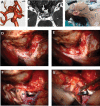Less Invasive Modified Extradural Temporopolar Approach for Paraclinoid Lesions: Operative Technique and Surgical Results in 80 Consecutive Patients
- PMID: 30210989
- PMCID: PMC6133696
- DOI: 10.1055/s-0038-1654703
Less Invasive Modified Extradural Temporopolar Approach for Paraclinoid Lesions: Operative Technique and Surgical Results in 80 Consecutive Patients
Abstract
Background Extradural temporopolar approach for paraclinoid lesions can provide extensive and early exposure of the anterior clinoid process, and complete mobilization and decompression of the optic nerve and internal carotid artery, which can prevent intraoperative neurovascular injury. The present study investigated the usefulness of our less invasive modified technique and discussed its operative nuances. Methods We retrospectively reviewed medical charts of 80 consecutive patients with neoplastic (21 patients) and vascular lesions (59 patients) who underwent the modified extradural temporopolar approach between September 2009 and March 2014. Results Preoperative visual acuity worsened in 4 patients (5.0%) and worsening of visual field function occurred in 10 patients (12.5%). Postoperative outcome was good recovery in 71 patients, moderate disability in 6, severe disability in 2, and death in 1 (due to reruptured aneurysm). No operation-related mortality occurred in the series. Conclusion Less invasive modified extradural temporopolar approach is safe and can be recommended for the surgical treatment of deeply located aneurysms and skull base tumors to reduce the risk of intraoperative optic neurovascular injury.
Keywords: anterior clinoid process; extradural temporopolar approach; paraclinoid aneurysm; paraclinoid tumors; skull base technique.
Figures



References
-
- Guidetti B, La Torre E. Management of carotid-ophthalmic aneurysms. J Neurosurg. 1975;42(04):438–442. - PubMed
-
- Sundt T M, Jr, Piepgras D G. Surgical approach to giant intracranial aneurysms. Operative experience with 80 cases. J Neurosurg. 1979;51(06):731–742. - PubMed
-
- Day J D, Giannotta S L, Fukushima T. Extradural temporopolar approach to lesions of the upper basilar artery and infrachiasmatic region. J Neurosurg. 1994;81(02):230–235. - PubMed
-
- Lee J H, Jeun S S, Evans J, Kosmorsky G.Surgical management of clinoidal meningiomas Neurosurgery 200148051012–1019., discussion 1019–1021 - PubMed
-
- Evans J J, Hwang Y S, Lee J H.Pre- versus post-anterior clinoidectomy measurements of the optic nerve, internal carotid artery, and opticocarotid triangle: a cadaveric morphometric study Neurosurgery 200046041018–1021., discussion 1021–1023 - PubMed
LinkOut - more resources
Full Text Sources
Other Literature Sources

